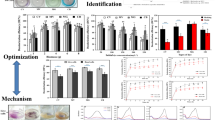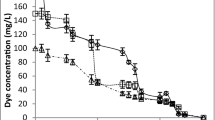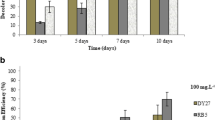Abstract
Pleurotus sajor-caju PS2001 was screened in Petri dish plates to assess the dye-decolorizing ability of industrial textile dyes. P. sajor-caju PS2001 was also cultivated in solid-state fermentation containing sawdust of Pinus sp. and wheat bran to obtain the enzymatic extract, showing laccase and manganese-peroxidase activity, which was used to test the capacity to degrade the textile dyes. Additional tests of decolorization were performed in liquid cultures. Anthraquinone-type textile dyes proved to be substrates for the enzymatic system of P. sajor-caju PS2001. Cultures in Petri dish plates showed that the anthraquinone dye Reactive Blue 220 can act as a redox mediator for the enzymatic reactions involved in the decolorization process, and enables the azo dye degradation. Reactive Blue 220 and Acid Blue 280 were completely decolorized in 30 min and 60 min, respectively, during the tests with precipitated enzymatic extract, while the azo dyes showed resistance to degradation. Additionally, in submerged cultures with dyes, veratryl alcohol oxidases and lignin peroxidase activities were observed. These results suggest that the strain P. sajor-caju PS2001 has great potential for use in the bioremediation technology of recalcitrant pollutant such as textile effluents.







Similar content being viewed by others
References
Abadulla E, Tzanov T, Costa S, Robra K, Cavaco-Paulo A, Gübitz GM (2000) Decolorization and detoxification of textile dyes with a laccase from Trametes hirsuta. Appl Environ Microbiol 66:3357–3362
Banat IM, Nigam P, Singh D, Marchant R (1996) Microbial decolorization of textile-dye-containing effluents: a review. Bioresour Technol 1996:217–227
Bourbonnais R, Paice MG (1988) Veratryl alcohol oxidases from the lignin-degrading basidiomycete Pleurotus sajor-caju. Biochem J 255:445–450
Brown D, Hitz HR, Schäfer L (1981) The assessment of the possible inhibitory effect of the dyestuffs on aerobic waste-water bacteria experience with a screening test. Chemosphere 10:245–261
Camarero S, Böckle B, Martínez MJ, Martínez AT (1996) Manganese-mediated lignin degradation by Pleurotus pulmonarius. Appl Environ Microbiol 62:1070–1072
Camarero S, Sarkar S, Ruiz-Dueñas FJ, Martínez MJ, Martínez AT (1999) Description of a versatile peroxidase involved in the natural degradation of lignin that has both manganese peroxidase and lignin peroxidase substrate interaction sites. J Biol Chem 274:10324–10330
Caramelo L, Martínez MJ, Martínez AT (1999) A search for ligninolytic peroxidases in the fungus Pleurotus eryngii involving α-keto-γ-thiomethylbutiric acid and lignin model dimers. Appl Environ Microbiol 65:916–922
Chi Y, Hatakka A, Maijala P (2007) Can co-culturing of two white-rot fungi increase lignin degradation and the production of lignin-degrading enzymes? Int Biodeterior Biodegrad 59:32–39
Chivukula M, Renganathan V (1995) Phenolic azo dye oxidation by laccase from Pyricularia oryzae. Appl Environ Microbiol 61:4374–4377
Claus H, Faber G, König H (2002) Redox-mediated decolorization of synthetic dyes by fungal laccases. Appl Microbiol Biotechnol 59:672–678
Cohen R, Persky L, Hadar Y (2002) Biotechnological applications and potential of wood-degrading mushrooms of the genus Pleurotus. Appl Microbiol Biotechnol 58:582–594
Cripps C, Bumpus JA, Aust SD (1990) Biodegradation of azo and heterocyclic dyes by Phanerochaete chrysosporium. Appl Environ Microbiol 56:1114–1118
Harkin JM, Obst JR (1973) Syringaldazine, an effective reagent for detecting laccase and peroxidase in fungi. Experientia 29:381–387
Heinfling A, Martinez MJ, Martinez AT, Bergbauer M, Szewzyk U (1998) Transformation of industrial dyes by manganese peroxidases from Bjerkandera adusta and Pleurotus eryngii in a manganese-independent reaction. Appl Environ Microbiol 64:2788–2793
Jarosz-Wilkolazka A, Kochmanska-Rdest J, Malarczyk E, Wardas W, Leonowicz A (2002) Fungi and their ability to decoulourize azo and antraquinonic dyes. Enzyme Microb Technol 30:566–572
Keller A, Gaio TA, Almeida PG, Claudino R, Riveros R, Dillon AJP (2002) Secreção de fenol-oxidases em cultivos de Pleurotus spp. crescidos em serragem de Eucalyptus sp. Paper presented at V Seminário Brasileiro de Tecnologia Enzimática. Universidade de Brasília, Brasília, 7–10 Apr 2002
Kumaran S, Sastry CA, Vikineswary S (1997) Laccase, cellulase and xylanase activities during growth of Pleurotus sajor-caju on sago hampas. World J Microbiol Biotechnol 13:43–49
Kuwahara M, Glenn JK, Morgan MA, Gold MH (1984) Separation and characterization of two extracellular H2O2-dependent oxidases from ligninolytic cultures of Phanerochaete chrysosporium. FEBS Lett 169:247–250
Leonowicz A, Grzywnowicz K (1981) Quantitative estimation of laccase forms in some white rot fungi using syringaldazine as a substrate. Enzyme Microb Technol 3:55–58
Mandels M, Reese ET (1957) Induction of cellulase in Trichoderma viride as influenced by carbon source and metals. J Bacteriol 73:269–278
Moreira MT, Feijoo G, Lema JM (2000) Evaluation of different fungal strains in the decolorisation of synthetic dyes. Biotechnol Lett 22:1499–1503
Munari FM, Gaio TA, Dillon AJP (2007) Phenol degradation and color removal in submerged culture of Pleurotus sajor-caju with paper mill effluents. Biocatal Biotrans 25:24–28
Nyanhongo GS, Gomes J, Gübitz GM, Zvauya R, Read J, Steiner W (2002) Decolorization of textile dyes by laccases from a newly isolated strain of Trametes modesta. Water Res 36:1449–1456
Pandey A, Selvakumar P, Soccol C, Nigam P (1999) Solid state fermentation for the production of industrial enzymes. Curr Sci 77:149–162
Paszczynski A, Crawford RL (1995) Potential for bioremediation of xenobiotic compounds by the white-rot fungus Phanerochaete chrysosporium. Biotechnol Prog 11:368–379
Revankar MS, Lele SS (2007) Synthetic dye decolorization by white rot fungus, Ganoderma sp. WR-1. Bioresour Technol 98:775–780
Rodríguez E, Pickard MA, Vazquez-Duhalt R (1999) Industrial dye decolorization by laccases from ligninolytic fungi. Curr Microbiol 38:27–32
Ruiz-Dueñas FJ, Martínez MJ, Martínez AT (1999) Heterologous expression of Pleurotus eryngii peroxidase confirms its ability to oxidize Mn2+ and different aromatic substrates. Appl Environ Microbiol 65:4705–4707
Sarkar S, Martínez AT, Martínez MJ (1997) Biochemical and molecular characterization of a manganese peroxidase isoenzyme from Pleurotus ostreatus. Biochem Biophys Acta 1339:23–30
Swamy J, Ramsay JA (1999) Effects of glucose and NH + 4 concentrations on sequential dye decoloration by Trametes versicolor. Enzyme Microb Technol 25:278–284
Tan YH, Wahab MN (1997) Extracellular enzyme production during anamorphic growth in the edible mushroom, Pleurotus sajor-caju. World J Microbiol Biotechnol 13:613–617
Tien M, Kirk TK (1984) Lignin-degrading enzyme from Phanerochaete chrysosporium: purification, characterization, and catalytic properties of a unique H2O2-requiring oxygenase. Proc Natl Acad Sci USA 81:2280–2284
Vares T, Kalsi M, Hatakka A (1995) Lignin peroxidases, manganese peroxidases, and other ligninolytic enzymes produced by Phlebia radiata during solid-state fermentation of wheat straw. Appl Environ Microbiol 61:3515–3520
Vicuña R, González B, Seelenfreund D, Rüttimann C, Salas L (1993) Ability of natural bacterial isolates to metabolize high and low molecular weight lignin-derived molecules. J Biotechnol 30:9–13
Wolfenden RS, Wilson RL (1982) Radical-cations as reference chromogens in the kinetic studies of one-electron transfer reactions: pulse radiolysis studies of 2,2′-azinobis-(3-ethylbenzthiazoline-6-sulphonate). J Chem Soc Perkin Trans 2:805–812
Wong Y, Yu J (1999) Laccase-catalyzed decolorization of synthetic dyes. Water Res 33:3512–3520
Yesilada O, Asma D, Cing S (2003) Decolorization of textile dyes by fingal pellets. Process Biochem 38:933–938
Acknowledgments
This work was supported by research grants from FAPERGS (Fundação de Amparo à Pesquisa do Rio Grande do Sul) and UCS (Universidade de Caxias do Sul). F. M. Munari received a fellowship from CAPES (Coordenação de Aperfeiçoamento de Pessoal de Nível Superior).
Author information
Authors and Affiliations
Corresponding author
Rights and permissions
About this article
Cite this article
Munari, F.M., Gaio, T.A., Calloni, R. et al. Decolorization of textile dyes by enzymatic extract and submerged cultures of Pleurotus sajor-caju . World J Microbiol Biotechnol 24, 1383–1392 (2008). https://doi.org/10.1007/s11274-007-9621-2
Received:
Accepted:
Published:
Issue Date:
DOI: https://doi.org/10.1007/s11274-007-9621-2




